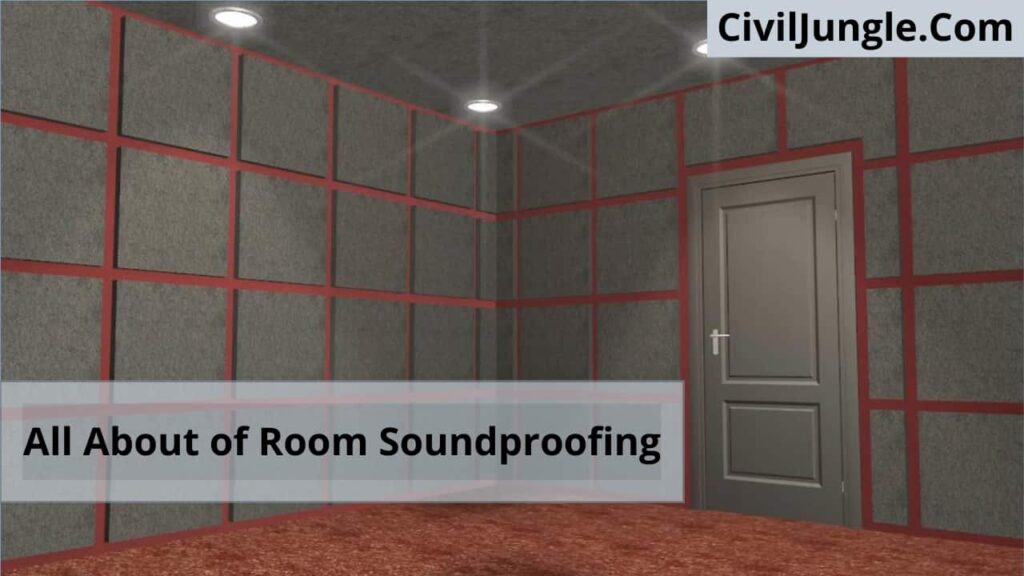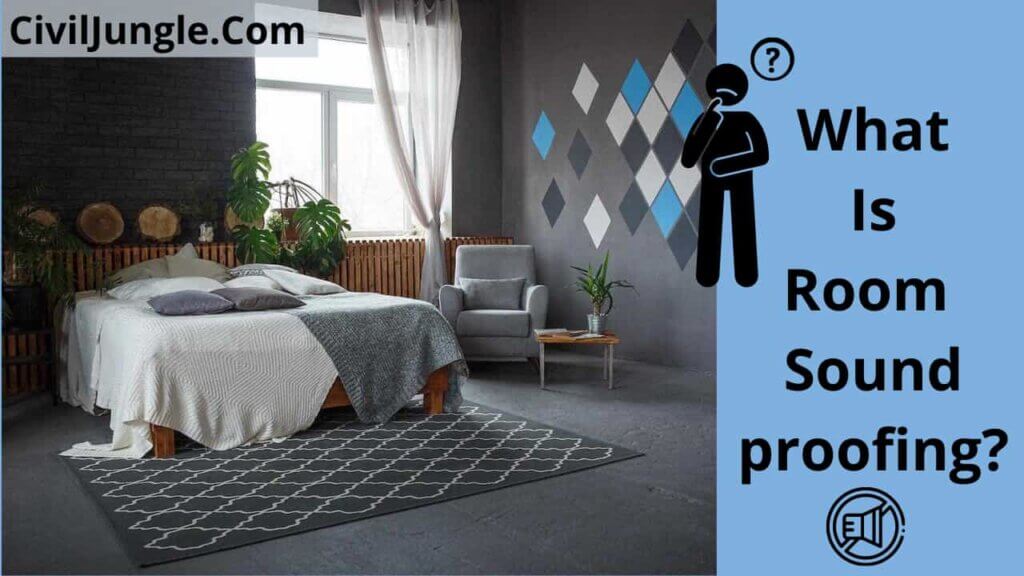
Introduction of Room Soundproofing
Room soundproofing means blocking the sound from getting in or out of the room. Some special materials are used to obstruct the sound Room soundproofing is needed to get relief from external noise.
What Is Room Soundproofing?

The action to prevent the sound from entering or escaping the room is called room soundproofing. Though there are other processes available to obstruct the sound, room soundproofing is the most suitable one to resolve the issue.
The materials used to soundproof the room are heavy and very dense, so they can reflect the sound and enclose it in a space.
Room Soundproofing Methods
Several methods can help to make a soundproofing room. Some of them are easy or non-constructing methods and others are constructing methods. These methods are described below-
1. Install Thick Carpets

The sound of the walking feet, paws can be annoying. Thicker carpets or mats are sound-absorbing, hence they can be used to muffle the sound of walking. Vibration insulation pads can also be used with the carpets to mount the sound of the speakers and other noise creating appliances.
2. Seal the Door

If the door frame has any gap at the bottom, sound can easily pass through it. To resolve the issue, installing a draft stopper, or sealing the door bottom is required.
3. Install Thick Blankets

Unwanted sound can be absorbed by mounting thick blankets to the wall. Heavy sound curtains can also give the same advantage.
4. Use Acoustic Panels

Acoustic panels (12×10inches) can absorb frequencies of low to high. Generally, these panels have an adhesive peel with them but in some cases, there is not.
In that case, spray adhesive should be used to glue the panels with the walls and ceilings too. Fiberglass panels are widely used due to their highest rating in sound absorption.
5. Use Thick Material

Drywall of 1.5cm can be used to absorb sound. The material will be of its best use if it is thick and dense enough. A wall frame can be made and attached through the existing wall for the best results
6. Decoupling

While sound travels from one substance to another, little amount of its energy gets absorbed Two sheets of sheetrock can be used to form a wall and the maximum gap between them can enhance the possibility of absorbing sound.
It is called Decoupling. To block low frequencies, Decoupling is used.
7. Stud Placement

A double row of studs or a staggered row of studs can be used instead of using a direct stud that connects both sides of the wall. It is one of the most used soundproofing methods.
8. Use Sound Clips or Channel

They are used to provide an extra barrier of sound between the dry well and the studs. Sound clips have heavy rubber components that help to block the sound.
Sound clips are inserted into the studs, followed by inserting a hat channel that is used to screw the dry well into it. Resilient channels are also used by screwing them through the studs and drywall for blocking high frequencies.
9. Use Damping Compounds

Sound energy is converted to heat by using these compounds. They are also called soundproofing glue. Low frequencies are absorbed by using this glue between layers of the walls, ceilings, etc.
10. Fill Cracks with Caulk

Sometimes small cracks and gaps cause trouble in soundproofing. To solve this problem acoustic caulks are used for filling the gaps Water-based caulk is easy to use but while using solvent-based caulk, it is necessary to check the level.
Otherwise, the materials attached to it can be damaged. Normal caulks are used to handle small gaps but in difficult situations, acoustic caulks can be used.
Best Way to Soundproof a Room

There are several ways. Some of them are listed below-
One of the most commonly used ways for soundproofing is Mineral wool insulation, as in comparison to others its cost is low and density is high. At first Spray foam should be used before mineral wool insulation for filling the gaps as a 2-3inch layer.
It is necessary to determine what noise should be absorbed Soft and sound-absorbing materials should be installed like upholstered furniture, rugs etc. Sound-absorbing acoustic tiles should be used.
Sound-blocking doors are needed to install. Noise-proof window inserts or Acoustic quilts have to be installed Sound-blocking wall, ceiling, and floor construction techniques should be explored.
Cost to Soundproof a House
The cost of soundproofing depends on the size of the area. It is almost $15 to $35 per square foot. Soundproofing an entire room can cost up to $1,200 to $2,500. The cost of labor is £30 to £50 per hour or about £400 per day.
Soundproofing Cost By Surface
1. Ceilings: Textured paint to the ceilings can cost up to $250 to $350. Using acoustic foam costs up to $15 to $120 per panel.
2. Walls: Soundproof materials cost up to$2 to $6 per square foot. The cost per sheet of soundproof drywall is $45.
3. Floors: The cost of the carpet is $1,200 per room. Mass-loaded vinyl has an average cost of $140 per 30-square-foot. Mlv will cost up to $400 for a 10 foot by 10-foot Loose-fill insulation has an average cost of $50 to $200.
4. Doors: Soundproofing blankets will cost up to $200 to $400 Soundproofing curtains will cost up to $20 to $80 per panel Sliding glass doors for $1,200 to $4,200.
5. Window: $200 to $1,000 per soundproofing window.
FAQs on Room Soundproofing
What Is Room Soundproofing?
Room soundproofing involves blocking sound from entering or escaping a room using various methods and materials to achieve noise reduction and enhance privacy.
What Are Some Common Methods for Soundproofing a Room?
Common methods include installing thick carpets, sealing doors, using thick blankets, acoustic panels, thick materials like drywall, decoupling, and using sound clips or channels.
How Effective Are Thick Carpets for Soundproofing?
Thick carpets are effective in absorbing sound and reducing noise from foot traffic and other sources. Adding vibration insulation pads can enhance their soundproofing capabilities.
What Is Decoupling in Soundproofing?
Decoupling involves separating layers of building materials, such as using two sheets of sheetrock with a gap in between, to prevent sound transmission and improve sound absorption.
Can Acoustic Panels Really Improve Sound Quality?
Yes, acoustic panels can absorb a wide range of sound frequencies, reducing echo and improving overall sound quality in a room. They are particularly effective for controlling high-frequency sounds.
How Much Does It Cost to Soundproof a Room?
The cost varies depending on the size of the room and the methods used. On average, soundproofing costs range from $15 to $35 per square foot, with total costs for a room ranging from $1,200 to $2,500.
What Is the Difference Between Soundproofing and Sound Absorption?
Soundproofing focuses on preventing sound from entering or leaving a room, while sound absorption aims to reduce echo and improve sound quality within the room by absorbing sound waves.
Are There Any Diy Methods for Soundproofing a Room?
Yes, some DIY methods include using thick blankets, sealing gaps with caulk, and installing carpets or rugs. However, more advanced techniques may require professional installation.
How Can I Soundproof Windows and Doors Effectively?
For windows, consider using soundproofing inserts or acoustic quilts. For doors, install draft stoppers, soundproofing blankets, or curtains to reduce noise transmission.
Is Professional Help Necessary for Soundproofing?
While some soundproofing methods can be done DIY, professional help may be needed for more complex installations or if you want to achieve higher levels of soundproofing.

